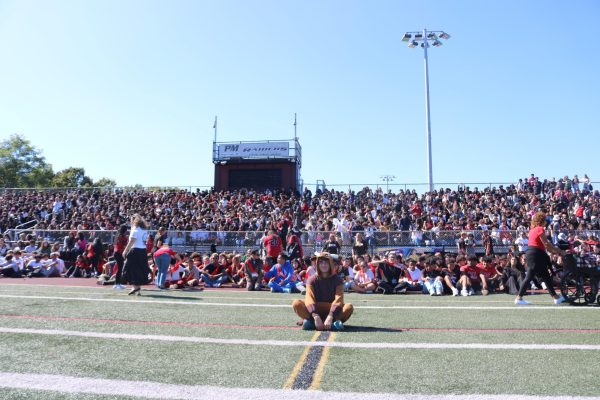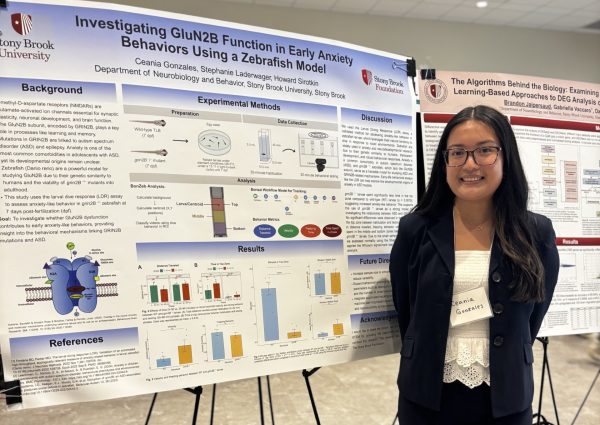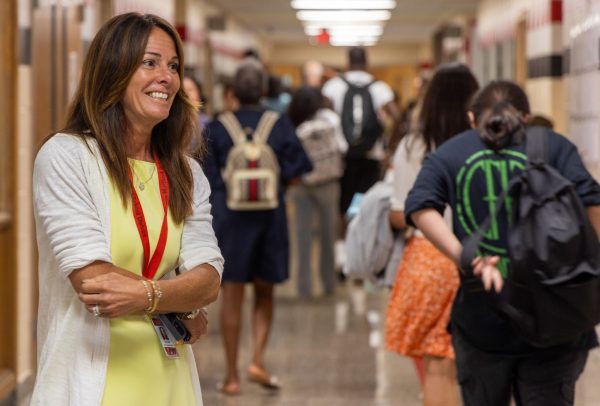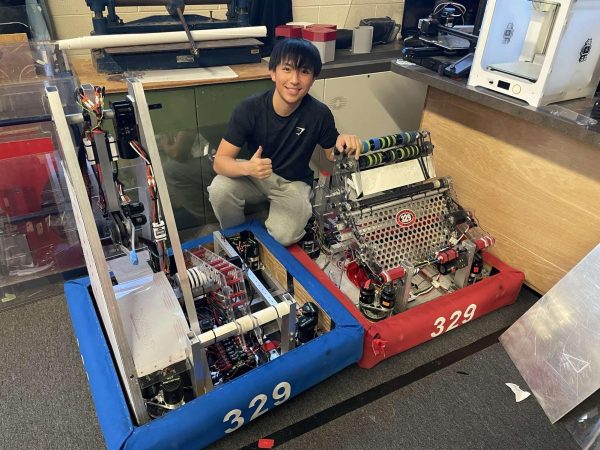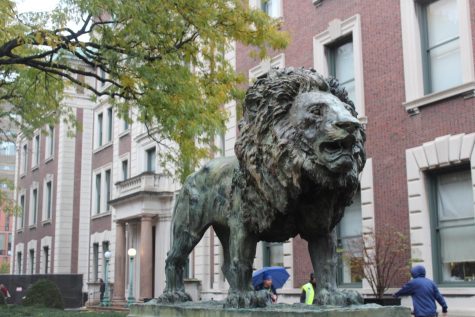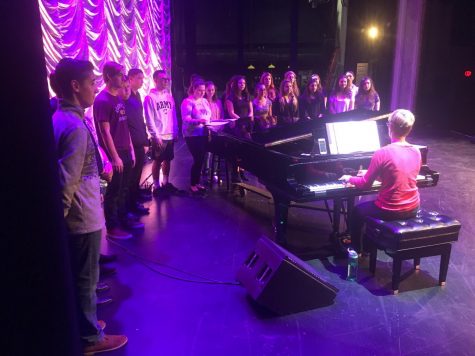The Truth to Building a Time Machine
Adelphi Quill Award Winner – 2nd place, Best Online Writing (2018).
Photo by Michael Alduino
Rob Niosi pictured with some Pat-Med alumni at Saturday’s screening event.
Time, for mankind, is both friend and foe. The dictator of every aspect of our lives, the construct that lays out the schedules and order of our civilized society, time is as finite as the sands of an hourglass. It is this force in nature, one that seems to be untouchable, unstoppable- and unbeatable. For these reasons, it has always perplexed the curious minds of mankind, always looking to gain the knowledge that the universe hides right in-front of us; time-travel is no different. Ever since the 1960s, with films such as HG Wells The Time Machine, it has left audiences and scientist everywhere pondering the possibility of controlling the one force that always ends up dominating us. However, the interest in such a phenomena can touch us all in many different ways: for Rob Niosi and Ronald Mallett, two juxtaposing individuals with similar beginnings, this idea is more than fiction.
Jay Cheel, a director and science-fiction enthusiast, became fascinated by the idea of time-travel and the individuals involved in the topic. After much research, he found two men, Niosi and Mallett, that became so enthralled in the world that Einstein marqueed, that he decided to begin a documentary: How to Build a Time Machine. Essentially, the documentary follows the journeys of Mallett and Niosi in their personal dreams of completing a time machine; the most interesting draw, however, is the purpose of each individual’s machine. On one hand, Mr. Niosi is not building a real, working time-machine in the sense that it can travel through space and time, rather, he wants to rebuild the machine that was in film inspired by the H.G. Wells’ novel The Time Machine (1960) that he saw back when he was a kid growing up in Patchogue. For him, building this machine was not about replicating the exact specifications of the movie prop, but to “recreate that feeling” he had when he first saw it in the cinema where his father worked. Originally, this project was meant to take him all of three months; well, suffice it to say that endeavor ended up turning into almost a decade’s worth of time and commitment. For his scene in the film, Cheel truly encapsulates the love and dedication Niosi had for his creation: the craftsmanship, the research, the traveling to different cities, the skills he had to learn, everything was a painstaking but exquisite process. By the end of the film, you could definitely see that this became more than a piece of art- it became his legacy.
On the other hand, we see an actual scientist in Ronald Mallett, a professor at the University of Connecticut. Unlike Niosi’s story, one of childhood love and ambition, Mallett’s was much more personal and heartbreaking to hear: as a child, his father, a T.V repairman, died of a massive heart-attack. As a result, his mother, his three brothers, and himself were left alone and lost in the world they have not been prepared for. However, for Mallett, this became his fuel, as he too became inspired by H.G. Wells’ time-machine’s eccentricity and he found on that day what his life’s work would be- to create a real, working, time-traveling apparatus. While in the film, Mallett does explain in a very simplified but still educational way how his machine would function, it would be a disservice for me to try and even begin to speak on the matter of Quantum Mechanics so, I shall not even attempt to do so. What I can say though, is the story behind his journey was truly beautiful and gave me chills listening to how strong the love between father and son, after so many years, can lead a man like Mallet to investing the time into doing what he does.
Overall, it was this juxtaposition yet overarching sense of unison that made the film so captivating and gripping to watch. In addition, the philosophical thoughts and questions raised by Niosi and Mallet made the viewer question the ideas in the film themselves and what they thought of the journeys. For those that were in attendance, the film left them with a message of motivation for anything in their own lives, that no matter how big or small a goal seemed to be, the satisfaction is more than worth it. As the credits rolled and the audience stood in mass approval, the truth was that only half the show was over- and the best part was just getting started.
As a former student of Pat-Med, Rob Niosi, class of 1971, took to the stage to give his comments on the film and recollecting what the whole experience was like for him. While up on stage, one could really get a sense for how humble and benevolent a man he was, that who was seen on the big screen was not just an actor, but a real person. Looking down at everyone in attendance, a smile grew on his face seeing many former friends and classmates that came back to support his work after all these years. In that respect, the film in a way was a time-machine of its own: a portal back, just for a few hours, to relive and reminisce about the memories and experiences all of the individuals shared as a collective. From this point, the questions began to pour in, from the skills he had to learn to create the machine to his next project and even more sentimental questions like what he learned about himself during the film. With every question asked, Niosi spent time to answer them in-full and as best as he could, to really give the audience an insight to who he was and why he decided to take on such an immense project on his own. Of course, this was not without interjecting some friendly banter and jokes which the audience, myself included, found quite enjoyable.
With one final applaud, the crowd began to exit while some of us stayed behind to speak with Rob and get to know him a little bit more. For me, I had the chance to speak with him one-on-one a few days before the screening to get to know the man behind the machine personally. From what I gathered and what I saw at the end of the film, he is a dedicated man who always will remember where it all began for him: Pat-Med. When speaking with him, I inquired more specifically about the role that his high school experience played in helping him become the man he is today, and what I found was that this community never left him after all these years. As he stated, “this is my memory”-referring to growing up in Pat-Med- and that the film program that began in 1969 was special to him because it allowed him to explore his “interest and to gain experience.” Moreover, I was especially curious as to why the film, inspired by H.G. Wells’ novel, had such a profound impact on him that it lit a fire that would burn for a lifetime. From what he equivocated, “it was a low budget-film that inspired a whole generation; and just as it did with Mallett, the same qualities that possessed me possessed him, and it truly spoke to that young boy in us.” The message that I was left with from this interview was that of wisdom and maturity- a true model for our generation to aspire after.
All-in-all, the event hosted by the Patchogue-Medford Hall of Fame Committee was superb and brought together, as always, “the past with the present.” If you have not seen the film and are interested do not fear, it will be coming to Hulu in due time according to Mr. Niosi. For now, while the movie is excellent, do not forget what the purpose of it was- to inspire the minds of the audience watching it.
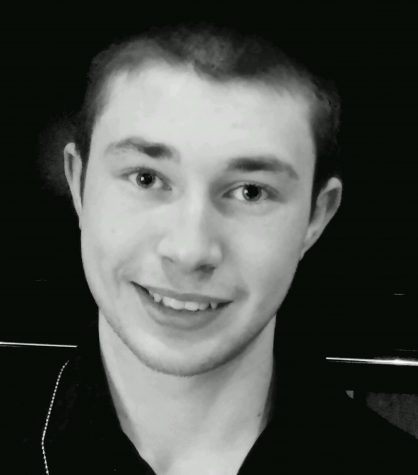
Grade 12
“Always dream and shoot higher than you know you can do. Don’t
bother just to be better than your contemporaries or predecessors. Try
to...


